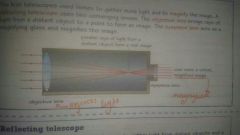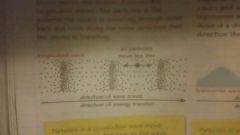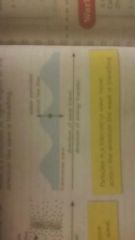![]()
![]()
![]()
Use LEFT and RIGHT arrow keys to navigate between flashcards;
Use UP and DOWN arrow keys to flip the card;
H to show hint;
A reads text to speech;
39 Cards in this Set
- Front
- Back
|
What did the astronomer PTOLEMY publish? |
The geocentric model That the earth was in the middle and the other planets were orbiting it in perfect circles |
|
|
What did the astronomer COPERNICUS publish? |
The heliocentric model Where the sun was in the middle, the plants were orbiting around it in perfect circles but the moon went around the earth |
|
|
What are the 3 ways we can observe the universe using light waves? |
*Using the naked eye - Not detailed enough - only up close stars *Using a telescope - see further objects in more detail - large lense provides more light *Photographs - record your findings -later studied on a computer |
|
|
Who was GALILEO and what did he disprove? |
*First astronomer to use a telescope *Noticed 4 moons around Jupiter *Not everything orbited the earth *Disproved the geocentric model |
|
|
What is reflection? |
Light bounces off a boundary between different materials |
|
|
What is refraction? |
When light passes from one material to another, through a boundary between 2 transparent materials at an angle the direction will change |
|
|
What are lenses? |
Specially shaped pieces of transparent material that change the direction of the light rays |
|
|
What is a converging lens? |
Makes the light rays come together |
|
|
What is the focal point? |
The point which the parallel rays are bought together |
|
|
What is the focal length? |
The distance between a lens and the focal point |
|
|
A diagram of a simple telescope |

|
|
|
What does a reflecting telescope use and do? |
A curved mirror to gather light from distant objects and a converging lens as an eyepiece to magnify the image |
|
|
What is wavelength and amplitude? |
*from the top/bottom of the wave to the next top/bottom *from the middle line to the top of the wave |
|
|
Examples of longitudinal waves |
Sound waves and seismic p waves |
|
|
In longitudinal waves how do the particles move? |

Move back and forth along the same direction that the sound is travelling |
|
|
Examples of transverse waves |
Water surface, electromagnetic waves and Seismic s waves |
|
|
How do the particles move in transverse waves? |

Move in the direction at right angles to the direction the wave is travelling |
|
|
Wave speed (m/s) = |
Frequency (Hz) x Wavelength (m) |
|
|
Distance (m) = |
Wave speed (m/s) x Time (s) |
|
|
The colours of the visible spectrum in order |
RED *Longest wavelength, lowest freq.* ORANGE YELLOW GREEN BLUE INDIGO VIOLET *Shortest wavelength, highest freq.* |
|
|
How did Herschel discover infrared? |
*Used a prism to split white light into the colours of the visible spectrum *He used a thermometer to see which end was hottest *The red end was the hottest *He continued to move the thermometer beyond the red *He found that the temperature was hotter *Discovered infrared radiation |
|
|
All electromagnetic waves... |
*are transverse waves *travel at the same speed in a vacuum |
|
|
The electromagnetic spectrum: |
RADIO WAVES MICRO WAVES INFRARED VISIBLE ULTRA VIOLET X RAYS GAMMA RAYS |
|
|
How to remember the electromagnetic spectrum |
R. Racing M. Mice I. Insulted V. Very U. Upset X. Xcellent G. Giraffes |
|
|
Dangers of Gamma rays and Xrays |
*Cause mutations to the DNA *May kill cells or cause cancer |
|
|
Danger of UV |
*damages skin cells causing sunburn *exposure to UV can cause skin cancer and damage eyes |
|
|
Dangers of infrared |
*Transfers heat energy so can cause burns |
|
|
Dangers of microwaves |
*Heat water inside our bodies *Can heat cells which damages them or kills them |
|
|
Uses of gamma rays |
*Sterilise food and medical equipment *scanners to detect cancer *to treat cancer |
|
|
Uses of Xrays |
*look inside objects *airport security scanners |
|
|
Uses of UV |
*Detect security marks made by fluorescent pens *inside fluorescent lamps *detect forged bank notes *disinfect water |
|
|
Uses of Visible light |
*photography *lights up rooms and allows us to see |
|
|
Uses of infrared |
*thermal imaging used by police *short range communications *remote controls for TVs |
|
|
Uses of microwaves |
*in mobile phones to communicate with satellites *for cooking (microwave ovens) |
|
|
Uses of radiowaves |
*broadcasting radio and TV programmes *communicating with ships and aeroplanes |
|
|
The higher the frequency... |
The more energy |
|
|
What are radioactive sources? |
Sources that naturally emit ionising radiation all of the time |
|
|
Examples of radioactive sources |
Alpha particles Beta particles Gamma Rays |
|
|
Effects of ionisation |
*Energy transferred but ionising radiation removes electrons from atoms to form ions *Ions ate reactive and van cause mutations to the DNA in cells *Damaged DNA can lead to cancer |

